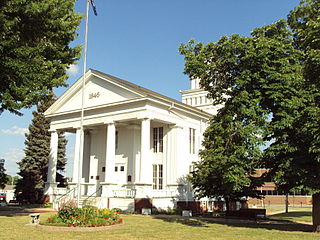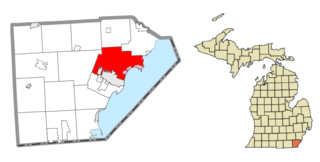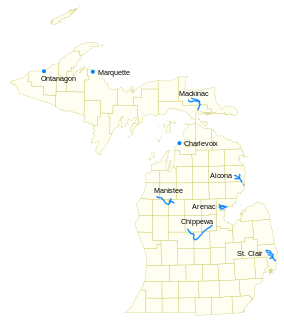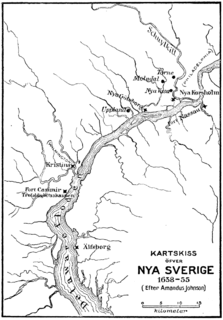Wenona was a historical settlement in the U.S. state of Michigan, located in what is now Bay City at 43°35′52″N83°53′53″W / 43.59778°N 83.89806°W . [1]

In the United States, a state is a constituent political entity, of which there are currently 50. Bound together in a political union, each state holds governmental jurisdiction over a separate and defined geographic territory and shares its sovereignty with the federal government. Due to this shared sovereignty, Americans are citizens both of the federal republic and of the state in which they reside. State citizenship and residency are flexible, and no government approval is required to move between states, except for persons restricted by certain types of court orders. Four states use the term commonwealth rather than state in their full official names.

Michigan is a state in the Great Lakes and Midwestern regions of the United States. The state's name, Michigan, originates from the Ojibwe word mishigamaa, meaning "large water" or "large lake". With a population of about 10 million, Michigan is the tenth most populous of the 50 United States, with the 11th most extensive total area, and is the largest state by total area east of the Mississippi River. Its capital is Lansing, and its largest city is Detroit. Metro Detroit is among the nation's most populous and largest metropolitan economies.

Bay City is a city in Bay County, Michigan, located near the base of the Saginaw Bay on Lake Huron. As of the 2010 census, the city's population was 34,932, and is the principal city of the Bay City Metropolitan Statistical Area, which is included in the Saginaw-Midland-Bay City Combined Statistical Area. The city, along with nearby Midland and Saginaw, form the Greater Tri-Cities region of Central Michigan, which has more recently been called the Great Lakes Bay Region.
The village was founded in 1863 by Henry W. Sage (1814-1897), a merchant and philanthropist, who along with John McGraw also founded the Sage, McGraw & Company sawmill on the west bank of the Saginaw River. [2] The sawmill, which was the largest in the state, was an early economic center of the community. [3] Sage initially platted the settlement with the name "Lake City", but because there was another Lake City in Michigan, it was renamed Wenona after the mother of Hiawatha in the poem by Henry Wadsworth Longfellow. George H. Bates became the first postmaster on February 14, 1865. Wenona incorporated as a village in 1867, and, in 1877 the Michigan Legislature consolidated Wenona with two other nearby villages, Banks and Salzburgh to form the city of West Bay City. In 1905, West Bay City merged with Bay City.

Henry Williams Sage was a wealthy New York State businessman, philanthropist, and early benefactor and trustee of Cornell University.

John McGraw was a wealthy New York State lumber merchant, philanthropist, early benefactor and trustee of Cornell University.

The Saginaw River is a 22.4-mile-long (36.0 km) river in the U.S. state of Michigan. It is formed by the confluence of the Tittabawassee and Shiawassee rivers southwest of Saginaw. It flows northward into the Saginaw Bay of Lake Huron, passing through Bay City, which developed around it in the 19th century. The watershed area is 8,595 square miles (22,260 km2).
The fortunes created from the sawmill operation in Wenona and the lumber industry it supported formed the basis of important early gifts to Cornell University.

Cornell University is a private and statutory Ivy League research university in Ithaca, New York. Founded in 1865 by Ezra Cornell and Andrew Dickson White, the university was intended to teach and make contributions in all fields of knowledge—from the classics to the sciences, and from the theoretical to the applied. These ideals, unconventional for the time, are captured in Cornell's founding principle, a popular 1868 Ezra Cornell quotation: "I would found an institution where any person can find instruction in any study."












